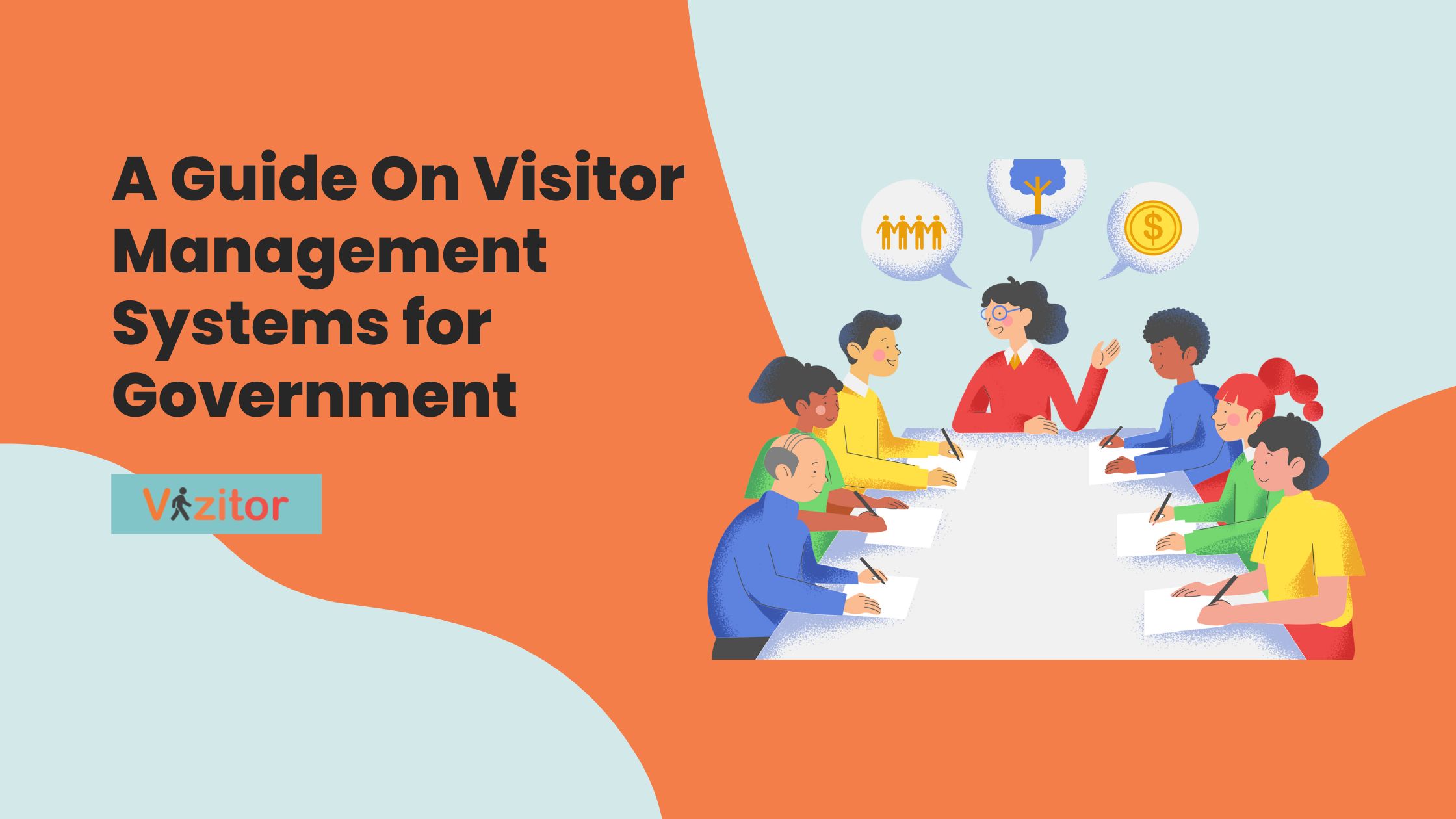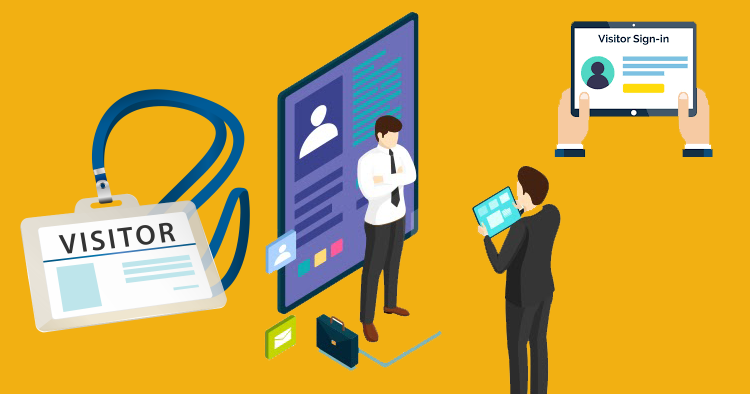Table of Content
Try Vizitor for Free!

Mon, Jul 8, 2024
Read in 11 minutes
Did you know? According to a recent security survey, 70% of government offices have reported unauthorized access incidents in the past year. With the rising need for enhanced security and efficient visitor tracking, a Visitor Management System (VMS) becomes indispensable.
This guide will delve into the essentials of Visitor Management Systems for government entities, including defense and aerospace sectors. It will cover the importance, key features, implementation best practices, and benefits of adopting a VMS, ensuring you have all the information needed to secure and streamline visitor management in high-security environments.
Importance of Visitor Management System in Government Offices

Visitor Management Systems (VMS) are critical in government offices, where security, efficiency, and data integrity are paramount. Here are some key reasons why implementing a VMS is essential:
1. Enhancing Security
Government offices handle sensitive information and operations, making security a top priority. A VMS helps in:
- Monitoring Access: Tracks who is entering and exiting the premises, ensuring that only authorized individuals have access.
- ID Verification: Verifies visitor identities through ID scans, reducing the risk of unauthorized access.
- Real-time Surveillance: Integrates with security systems such as CCTV to continuously monitor visitor activities.
2. Streamlining Processes
A VMS automates and simplifies the visitor management process, which includes:
- Pre-registration: Allows visitors to pre-register their visit, reducing wait times and speeding up the check-in process.
- Automated Check-in/Check-out: Facilitates quick and efficient visitor check-ins and check-outs through digital kiosks or mobile apps.
- Badge Printing: Automatically prints visitor badges with photo ID and access level, ensuring that all visitors are easily identifiable.
3. Data Management and Compliance
Maintaining accurate visitor records is crucial for both security and regulatory compliance:
- Accurate Record-Keeping: Keeps detailed logs of all visitors, including their personal information, purpose of visit, and time of entry and exit.
- Data Security: Protects visitor data with secure storage and access controls, ensuring compliance with privacy regulations.
- Audit Trails: Provides comprehensive audit trails that can be used for security investigations and regulatory audits.
4. Improving Visitor Experience
A VMS enhances the overall experience for visitors by:
- Reducing Wait Times: Streamlines the check-in process, minimizing waiting times and improving visitor satisfaction.
- Providing Clear Instructions: Offers clear instructions and directions to visitors, ensuring they can easily navigate the facility.
- Personalized Service: Allows staff to prepare for visitor arrivals in advance, offering a more personalized and efficient service.
5. Emergency Management
In case of emergencies, a VMS plays a crucial role in:
- Evacuation Management: Provides real-time data on the number of visitors and their locations within the facility, aiding in efficient evacuation.
- Emergency Notifications: Sends instant notifications to visitors and staff during emergencies, ensuring timely communication and response.
- Visitor Tracking: Helps in accounting for all visitors during and after an emergency, ensuring everyone’s safety.
Benefits of a Visitor Management System in Government
1. Enhanced Surveillance
- Continuous Monitoring: Provides real-time data on visitor locations and movements, allowing for immediate response to any suspicious activity.
- Detailed Logs: Maintains detailed logs of visitor activity, which can be reviewed for security audits and investigations.
2. Improved Access Control
- Zone-based Access: Controls access based on specific zones within the establishment, ensuring that visitors can only access areas relevant to their visit.
- Temporary Access Badges: Issues temporary access badges that expire at the end of the visit, preventing misuse.
3. Emergency Response
- Efficient Evacuation: Provides real-time information on the number and location of visitors, aiding in efficient evacuation during emergencies.
- Instant Notifications: Sends out instant notifications to visitors and staff in case of emergencies, ensuring timely communication.
4. Compliance and Reporting
- Regulatory Compliance: Helps in complying with defense regulations and standards by maintaining accurate and secure visitor records.
- Audit Trails: Provides comprehensive audit trails that can be used for security audits and compliance checks.
Key Features of Visitor Management System for Defense
1. Biometric Verification
- Accurate Identification: Ensures that the person entering is indeed who they claim to be, reducing the risk of impersonation.
- Enhanced Security: Biometric data adds an extra layer of security, making it harder for unauthorized individuals to gain access.
2. Escort Management
- Controlled Access: Ensures visitors are always accompanied by authorized personnel, especially in high-security zones.
- Accountability: Keeps track of who is responsible for each visitor, adding a layer of accountability.
3. Integration with Security Systems
- Comprehensive Monitoring: Integrates with existing security systems such as CCTV, alarms, and access control systems to provide a holistic security solution.
- Automated Alerts: Triggers alerts in case of any security breaches or unauthorized access attempts.
4. Visitor Screening
- Background Checks: Conducts thorough background checks on visitors before granting access, ensuring that no potential threats are allowed entry.
- Pre-approval Processes: Requires pre-approval for visitors, especially for sensitive areas, ensuring that all visits are vetted in advance.
Role of Visitor Management System in Aerospace Facilities
Aerospace facilities are at the forefront of technology and innovation, often dealing with sensitive projects and critical operations. Implementing a Visitor Management System (VMS) in these environments is crucial for maintaining security, protecting intellectual property, and ensuring compliance. Here’s a detailed look at the role of VMS in aerospace facilities.
Protecting Intellectual Property
Aerospace facilities often handle proprietary technologies and confidential information. A VMS helps protect intellectual property by:
- Controlling Access: Restricts visitor access to sensitive areas based on their role and purpose of visit.
- Visitor Identification: Ensures that all visitors are properly identified and logged, reducing the risk of unauthorized access.
- Non-Disclosure Agreements (NDAs): Facilitates the signing of electronic NDAs before visitors can access sensitive areas, ensuring legal protection.
Key Features for Aerospace Facilities
Non-Disclosure Agreements (NDAs)
- Electronic Signing: Allows visitors to sign NDAs electronically during the check-in process, ensuring compliance with confidentiality requirements.
- Automated Record Keeping: Maintains a secure record of all signed NDAs for legal and compliance purposes.
Detailed Visitor Logs
- Comprehensive Tracking: Keeps detailed logs of all visitor activities, including the areas accessed, duration of stay, and purpose of visit.
- Audit Trails: Provides audit trails that can be used for security investigations and compliance audits.
Visitor Induction
- Safety Training: Provide safety and compliance training for visitors before granting access to specific areas, ensuring they are aware of the facility’s protocols.
- Customized Briefings: Offers tailored induction briefings based on the visitor’s role and the areas they will be accessing.
Zone-based Access
- Controlled Entry: Implements zone-based access controls, allowing visitors to enter only the areas relevant to their visit.
- Temporary Badges: Issues temporary badges with access restrictions that expire at the end of the visit, preventing misuse.
Regulating Visitor Flow
Managing the flow of visitors is critical in aerospace facilities to prevent disruptions and maintain security:
- Pre-registration: Allows visitors to pre-register their visit, streamlining the check-in process and reducing wait times.
- Automated Check-in/Check-out: Facilitates quick and efficient check-in and check-out processes through digital kiosks or mobile apps.
- Visitor Scheduling: Enables the facility to schedule and manage visitor appointments, ensuring that visits are well-coordinated and do not interfere with critical operations.
Ensuring Compliance
Aerospace facilities must adhere to stringent industry regulations and standards. A VMS aids in ensuring compliance by:
- Accurate Record-Keeping: Maintains accurate and secure records of all visitors, including their personal information, visit details, and access levels.
- Regulatory Reporting: Generates reports required for regulatory compliance, helping the facility meet industry standards and avoid penalties.
- Data Security: Protects visitor data with advanced security measures, ensuring compliance with data protection regulations.
Implementing a Visitor Management System for Government
Implementing a Visitor Management System (VMS) in government offices, defense establishments, and aerospace facilities is crucial for enhancing security and operational efficiency. Here are the key steps to ensure successful implementation:
1. Define Security Policies
Establishing clear security policies is the foundation for effective visitor management. These policies should outline the procedures for visitor access and management, ensuring consistency and compliance across all departments.
- Access Control: Define which areas are restricted and who can access them.
- Identification Requirements: Specify the identification documents required for visitors.
- Check-in/Check-out Procedures: Detail the process for visitor check-in and check-out, including pre-registration and on-site verification.
- Emergency Protocols: Establish procedures for managing visitors during emergencies, including evacuation plans and communication strategies.
2. Choose the Right Visitor Management System
Selecting a VMS that aligns with your specific security needs and operational requirements is critical. Consider the following factors when choosing a system:
- Security Features: Look for features such as ID and biometric verification, real-time monitoring, and integration with existing security systems.
- User-Friendliness: Ensure the system is easy to use for both staff and visitors, with intuitive interfaces and clear instructions.
- Scalability: Choose a system that can grow with your needs, accommodating an increasing number of visitors and expanding functionalities.
- Compliance: Ensure the system complies with relevant regulations and standards, particularly concerning data protection and privacy.
3. Train Staff
Proper training is essential for the effective use of a VMS. Ensure that all staff members involved in visitor management are thoroughly trained on the system’s functionalities and protocols.
- System Training: Provide comprehensive training on how to use the VMS, including check-in/check-out processes, ID verification, and badge printing.
- Security Protocols: Train staff on the security policies and procedures related to visitor management, ensuring they understand the importance of each step.
- Emergency Procedures: Educate staff on how to handle visitors during emergencies, including evacuation and communication protocols.
4. Regular Audits
Conducting regular audits helps ensure compliance with security policies and identifies areas for improvement. Audits should cover:
- Visitor Records: Review visitor logs to ensure accuracy and completeness.
- System Performance: Evaluate the VMS’s performance, checking for any technical issues or inefficiencies.
- Policy Compliance: Assess whether the established security policies are being followed correctly by staff.
- Feedback Analysis: Analyze feedback from staff and visitors to identify common issues or suggestions for improvement.
5. Feedback Mechanism
Implementing a feedback system is crucial for the continuous improvement of the visitor management process. Collect feedback from both staff and visitors to:
- Identify Pain Points: Understand the challenges and difficulties encountered by users.
- Gather Suggestions: Collect ideas and suggestions for enhancing the visitor management process.
- Measure Satisfaction: Assess the overall satisfaction of visitors and staff with the VMS.
- Implement Changes: Use the feedback to make informed changes and improvements to the system and procedures.
Why Choose Vizitor?
With Vizitor, you can greet your visitors with an impressive and professional welcome screen. This not only creates a great first impression but also enhances the visitor experience by making the check-in process more engaging and user-friendly.
Vizitor allows you to add your brand logo and customize the interface to reflect your organization’s branding. This helps reinforce your brand identity and creates a cohesive experience for visitors from the moment they enter your facility.
Vizitor provides the option to create customized visitor badges. You can include essential information such as the visitor’s name, photo, purpose of visit, and access level. Customized badges improve security by ensuring that all visitors are easily identifiable and have the appropriate access permissions.
Top Security Features
Security is paramount when it comes to visitor management, and Vizitor excels in this area with:
- ID Verification: Ensures that visitors are who they claim to be by verifying their identification documents.
- Real-time Monitoring: Tracks visitor movements in real-time, providing immediate visibility into who is in your facility and where they are.
- Data Protection: Complies with data protection regulations to ensure that all visitor information is securely stored and managed.
- Ultimate One-Stop Solution
- Vizitor is designed to be a comprehensive visitor management solution, offering a wide range of features that cater to all your visitor management needs. From pre-registration and automated check-ins to detailed visitor logs and compliance reporting, Vizitor covers it all.
Efficient Visitor Management
Vizitor streamlines the entire visitor management process, making it efficient and hassle-free. Key benefits include:
- Quick Check-ins: Reduces waiting times with fast and automated check-in processes.
- Visitor Scheduling: Allows for pre-registration and scheduling of visits, ensuring that all visits are well-coordinated.
- Emergency Management: Provides real-time data on visitor locations, aiding in efficient evacuation and emergency response.
Frequently Asked Questions
Why is a VMS important for government offices?
Ans. A VMS is crucial for government offices to:
- Enhance security by controlling and monitoring visitor access.
- Ensure compliance with regulatory requirements.
- Protect sensitive information and areas.
- Improve operational efficiency and visitor experience.
How does a VMS enhance security in government facilities?
Ans. A VMS enhances security by:
Verifying visitor identities through ID checks and biometric scans.
Restricting access to sensitive areas based on visitor roles.
Providing real-time monitoring of visitor movements.
Maintaining detailed logs of all visitor activities.
How does a VMS ensure compliance with regulations?
Ans. A VMS ensures compliance by:
Keeping accurate and secure records of all visitors.
Facilitating the signing of electronic non-disclosure agreements (NDAs).
Generating necessary reports for regulatory audits.
Protecting visitor data with advanced security measures.
Can a VMS be customized to fit the needs of different government departments?
Ans. Yes, a VMS can be customized to meet the specific needs of different government departments. Customization options may include branded interfaces, tailored check-in processes, specific access controls, and unique visitor badges.
How does a VMS handle emergencies?
Ans. In emergencies, a VMS:
Provides real-time data on visitor locations for efficient evacuation.
Sends instant notifications to visitors and staff.
Helps account for all visitors during and after an emergency.
What are the steps to implement a VMS in a government facility?
Ans. To implement a VMS:
Define security policies for visitor access and management.
Choose a VMS that aligns with security needs and operational requirements.
Train staff on using the VMS effectively.
Conduct regular audits to ensure compliance and identify areas for improvement.
Implement a feedback mechanism for continuous improvement.
How does a VMS protect visitor data?
Ans. A VMS protects visitor data by:
Using encryption for data storage and transmission.
Implementing access controls to restrict who can view or edit visitor data.
Complying with data protection regulations to ensure privacy and security.
Can a VMS integrate with existing security systems?
Ans. Yes, most VMS solutions can integrate with existing security systems such as CCTV, access control systems, and alarm systems to provide a comprehensive security solution.









